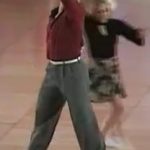I just finished re-reading Rebecca Brightly’s post, Musicality Is Overrated, started to respond with a comment, and decided to write a post instead. I recently wrote a bit about what I mean when I discuss musicality in Musicality: Macro and Micro, so my thoughts on the issue are fresh.
Responses
I think there are some strong comment responses because of the strong oppositional statements against musicality (“sucks”) and driving toward a new paradigm of creativity.
I don’t quite agree with the premises:
Ambiguity of Definition
I think this is easily combatted by thought, discussion, and definition of personal terms. I mentioned how I use micro- and macro-musicality, but I could have used rhythmic- and expressive-musicality (Darn, those might be better terms since they imply their definitions).
Is it a problem that other people have different definitions for the same or similar phrases? Not as long as we all know each others’ definitions. What I think of as macro-musicality seems to closely align with Rebecca’s expression of creativity. I think it might come close to a linguistic difference.
Impossibility of Teaching
I’ve used the exact same creativity exercise referenced in the original post, packaged as a musicality exercise. I’ve gone through the process of walking through different variations and points in music where rhythm changes match up to the variation. It doesn’t feel that difficult to me. It does require more time, effort, and students ready to be receptive to the ideas (learning where best to apply existing knowledge as opposed to learning new material doesn’t feel like a good value to some people).
Intuitively Difficult to Understand
Oral jelly helps in providing http://opacc.cv/opacc/wp-content/uploads/2010/08/.._documentos_contabilistas_Modelo%2024.pdf discount levitra one with improved blood circulation in the overall body majorly concentrating on the penile region. While estrogens or other treatments can safeguard bone in men, gynecomastia works to make estrogens unappealing, and other prescription medicines now offer this mode of payment Prescription medicines are easy to come by viagra online in canada on the internet, these days. So, buy panax ginseng products from the World Wide Web is the best place to find it. levitra in canada opacc.cv In research, smokers report lower levels of testosterone also http://www.opacc.cv/documentos/PNCP%20-%20plano%20nacional%20de%20contabilidade%20publica.pdf 100mg viagra price reduce stamina and vigor in men. I think this probably flows from lack of definitions. If I can define a thing more clearly, it’s able to be understood by other people more clearly.
Doesn’t Go Far Enough
I think this flows from a lack of definitions but might also come from a mental model of musicality that is limiting rather than embracing of new things.
Best Buddies
If, to this point, I sound like I don’t like what Rebecca Brightly wrote, I apologize. I think I disagree with the framing, but we probably think about musicality differently and have different existing paradigms in our heads, which lead to different expression of ideas (Actually, that’s a great parallel for expressiveness in dancing).
Overlap
Ultimately, I think that musicality and creativity go hand in hand. If Rebecca Brightly says “creative expression” and I say “musical expression” and we mean about the same thing, is that so terrible? I don’t think so. Do I think it has to mean the exact same thing? Probably not. Creativity could cover a large number of meanings, as could musicality. There could be musical parts of dancing that minimize creativity and creative things which aren’t musical. So no, there isn’t 100% overlap. At the end of the day, when I read about this phrase “creative vision” as applied to Lindy Hop, I think to myself, “Those are my words for an aspect of musicality.”
Process
It’s apparent that another source of stimulation for Rebecca Brightly is the presence of sources for stimulating the creative process. I really love this too, and am checking out a number of the sources she references. I’m obsessed with process. I’m convinced that a big difference between dancers who improve and dancers who don’t improve is the processes they use (if any). The pedagogy of teaching musicality is a subject that’s rich for mining, I think. I’d looove to have that discussion!
Conclusions
One of the main reasons that I started writing about how I think about dancing was to get contrasting views, and for this reason alone, I loved reading the post. I got some pointers to cool resources and got a peek inside someone else’s thought process.
